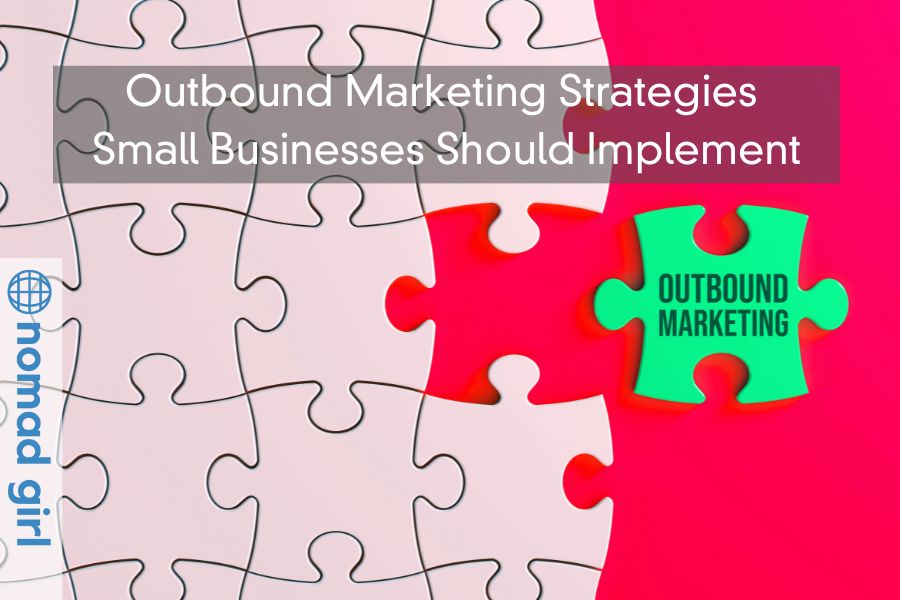Most Digital Nomads run small businesses and in the ever-evolving marketing landscape, small businesses often navigate myriad strategies to reach their target audience. While digital and inbound marketing techniques have gained prominence in recent years, the power of outbound marketing should not be underestimated.
In this article, we will explore a range of strategies that small businesses should consider implementing to effectively connect with potential customers, broaden their reach, and drive growth. From traditional methods to modern twists, we’ll delve into practical approaches that can help any company thrive in a competitive marketplace.
What is Outbound Marketing?
Outbound marketing is a traditional marketing approach where a business initiates contact with potential customers to promote its products or services. Unlike inbound marketing, which relies on attracting customers through content, search engine optimization, and other non-intrusive methods, outbound marketing is more proactive and often involves reaching out to prospects directly.
Key characteristics of it include:
- Advertising: Outbound marketing commonly employs advertising methods such as TV commercials, radio ads, print media (newspapers, magazines), billboards, and display ads to convey messages to a broad audience.
- Telemarketing: It involves making outbound calls to potential customers to introduce products or services, conduct surveys, or generate leads.
- Email marketing: Though it can overlap with inbound marketing, outbound email marketing entails sending promotional emails or newsletters to a list of recipients, often purchased or acquired through various means.
- Direct mail: Sending physical promotional materials, such as brochures, catalogs, or postcards, to a targeted list of potential customers through postal mail.
- Cold calling: Sales representatives contact potential clients who have yet to express prior interest in the company’s offerings. This method is commonly used in B2B (business-to-business) sales.
- Door-to-door sales: Salespeople visit individual homes or businesses to promote and sell products directly to clients. This last one is a bit more difficult to achieve as a Digital Nomad.
These strategies can be effective and strategically executed, especially for small enterprises that want to raise awareness, reach a wide audience, or generate immediate leads. However, they can also be perceived as interruptive and may need more support from consumers who prefer non-intrusive approaches. Modern outbound advertising often incorporates digital channels and data-driven targeting to make outreach more relevant and personalized, balancing effectiveness and customer engagement.
8 Outbound Marketing Strategies for Small Businesses to Implement
These strategies can be effective for small companies to maximize sales and reach potential clients. Here are eight of them:
1. Email marketing
- Build and maintain an email list of potential customers.
- Send targeted and personalized email campaigns.
- Use email automation tools to schedule and optimize your email sends.
- Include compelling offers and call-to-action buttons in your emails.
2. Cold calling
- Identify and research your target audience.
- Develop a script and train your sales team.
- Use a customer relationship management (CRM) system to track leads and conversations.
- Focus on building relationships and providing value during calls.
3. Direct mail
- Create eye-catching and informative direct mail materials.
- Define a specific target audience for your mailings.
- Include a strong call to action and contact information.
- Measure the success of your direct mail campaigns by tracking responses.
4. Pay-per-click (PPC) advertising
- Set up targeted PPC campaigns on Google Ads or social media platforms.
- Use relevant keywords and ad copy to attract potential customers.
- Monitor and optimize your campaigns regularly to improve ROI.
- Allocate your budget strategically to maximize results.
5. Telemarketing
- Hire or train a telemarketing team.
- Develop a clear and compliant calling script.
- Focus on qualifying leads and setting up appointments for sales.
- Ensure compliance with relevant regulations like the Do-Not-Call list.
6. Trade shows and events
- Participate in industry-specific trade shows and events.
- Create an appealing booth and promotional materials.
- Engage with attendees, collect leads, and follow up promptly.
- Use these events to showcase your products or services.
7. Referral marketing
- Encourage satisfied customers to refer others.
- Implement a referral program with incentives for referrals.
- Leverage word-of-mouth marketing to reach new customers.
- Monitor and reward customers who refer your business.
8. Social media advertising
- Use paid social media advertising to target specific demographics.
- Create visually appealing and engaging ad content.
- Utilize A/B testing to refine your ad campaigns.
- Monitor ad performance and adjust your strategy as needed.
Remember that the key to successful outbound marketing is to tailor your approach to your target audience, monitor the effectiveness of each strategy, and adjust your tactics based on the results. Additionally, compliance with relevant regulations, such as CAN-SPAM for email marketing and telemarketing rules, is essential to avoid legal issues.
How to Choose the Right Strategy for Your Business
Choosing the right advertising strategy for your company is crucial in achieving your goals and effectively reaching your target audience. Here are the steps to help you make an informed decision:
1. Set clear goals
Start by defining your main objectives. Are you looking to increase brand awareness, generate leads, boost sales, or something else? Your goals will guide your marketing strategy.
2. Know your target audience
Understand your ideal customer’s demographics, interests, pain points, and behaviors. Creating detailed buyer personas can help you tailor your advertising approach to their needs.
3. Analyze your competition
Study your competitors’ marketing efforts. What strategies are they using, and what seems to work for them? This can give you insights into what might work for your business.
4. Assess your resources
Consider your budget, team size, and time constraints. Your available resources will determine the scope and complexity of your efforts.
5. Create a content plan
Develop a content marketing strategy that provides value to your audience and supports your goals. Plan out what type of content you’ll create (e.g., blog posts, videos, infographics) and how often you’ll publish.
6. Allocate your budget
Allocate your budget based on the marketing channels and tactics you use. Some channels may require more financial investment than others, so prioritize where you’ll get the most ROI.
7. Integrate your efforts
Ensure your marketing efforts are integrated across different channels. Consistent messaging and branding are crucial for building a strong brand identity.
8. Seek professional advice
If you need help deciding which marketing strategy to pursue or lack in-house expertise, consider consulting with professionals or agencies who can provide valuable insights and assistance. If you already know someone who can help but have forgotten their contact details, turn to Nuwber.
9. Monitor ROI
Evaluate each marketing channel and tactic’s return on investment (ROI). Focus your resources on the strategies that deliver the best results.
Conclusion
Outbound marketing can complement your overall efforts, helping you reach a broader audience, generate immediate leads, and establish your brand presence. Even though the 21st century has brought more modern methods, such as SEO, webinars, and podcasts, old tactics that are still effective can bring the necessary results every company dreams about.


















